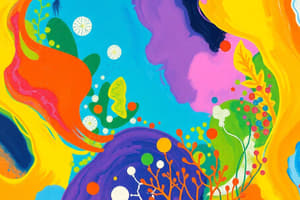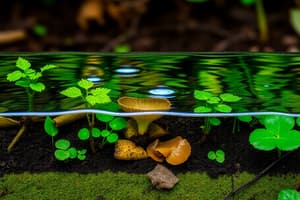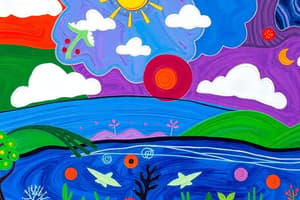Podcast
Questions and Answers
Role of nitrogen fixing bacteria N2 + Hydrogen ……nitrogen cpd
Role of nitrogen fixing bacteria N2 + Hydrogen ……nitrogen cpd
ammonia/ammonium ions
Proteins ………………amino acids
Proteins ………………amino acids
decompose into
Amino acids ………….ammonium ions and sugars
Amino acids ………….ammonium ions and sugars
can be converted to
Why do we need nitrogen?
Why do we need nitrogen?
What factors affect the carbon cycle?
What factors affect the carbon cycle?
What is the primary role of nitrifying bacteria?
What is the primary role of nitrifying bacteria?
At each trophic level, there is a _______ of energy being transferred.
At each trophic level, there is a _______ of energy being transferred.
What is the definition of a food web?
What is the definition of a food web?
Pyramids of _____ represent the amount of energy present at each trophic level.
Pyramids of _____ represent the amount of energy present at each trophic level.
Monoculture increases the risk of spread of disease.
Monoculture increases the risk of spread of disease.
What are the negative effects of using pesticides?
What are the negative effects of using pesticides?
Which of the following is a positive effect of using artificial fertilizers?
Which of the following is a positive effect of using artificial fertilizers?
Selective breeding improves _______ of animals and plants.
Selective breeding improves _______ of animals and plants.
What is genetic diversity?
What is genetic diversity?
Give an example of a genetically engineered product.
Give an example of a genetically engineered product.
Deforestation leads to less oxygen concentration in the atmosphere.
Deforestation leads to less oxygen concentration in the atmosphere.
What is the goal of conservation?
What is the goal of conservation?
What is a major cause of decreased fish populations?
What is a major cause of decreased fish populations?
Genetic engineering can lead to the creation of _______ weeds.
Genetic engineering can lead to the creation of _______ weeds.
What solution can help prevent eutrophication?
What solution can help prevent eutrophication?
Flashcards
Nitrogen-fixing bacteria
Nitrogen-fixing bacteria
Bacteria that converts nitrogen gas into ammonia, enriching the soil naturally.
Saprophytic bacteria/Decomposers
Saprophytic bacteria/Decomposers
Bacteria that break down organic matter, releasing nutrients back into the environment.
Nitrifying bacteria
Nitrifying bacteria
Bacteria that convert ammonium ions into nitrites, then nitrates, in the soil.
Denitrification
Denitrification
Signup and view all the flashcards
Deforestation
Deforestation
Signup and view all the flashcards
Burning Fossil Fuels
Burning Fossil Fuels
Signup and view all the flashcards
Enhanced Greenhouse Effect
Enhanced Greenhouse Effect
Signup and view all the flashcards
Producer
Producer
Signup and view all the flashcards
Decomposers
Decomposers
Signup and view all the flashcards
Carnivores
Carnivores
Signup and view all the flashcards
Herbivores
Herbivores
Signup and view all the flashcards
Trophic Level
Trophic Level
Signup and view all the flashcards
Food Web
Food Web
Signup and view all the flashcards
Pyramid of Numbers
Pyramid of Numbers
Signup and view all the flashcards
Pyramid of Biomass
Pyramid of Biomass
Signup and view all the flashcards
Pyramid of Energy
Pyramid of Energy
Signup and view all the flashcards
Monoculture
Monoculture
Signup and view all the flashcards
Genetic diversity
Genetic diversity
Signup and view all the flashcards
Genetically Engineered Plants
Genetically Engineered Plants
Signup and view all the flashcards
Deforestation
Deforestation
Signup and view all the flashcards
Causes of Air Pollution
Causes of Air Pollution
Signup and view all the flashcards
Causes of Water Pollution
Causes of Water Pollution
Signup and view all the flashcards
Conservation
Conservation
Signup and view all the flashcards
Adaptive features
Adaptive features
Signup and view all the flashcards
Endangered Species
Endangered Species
Signup and view all the flashcards
Study Notes
- Ecology is the study of the relationships between living organisms and their environment.
Nutrient Cycles
- Nutrient cycles are processes that move essential elements through the biotic and abiotic components of an ecosystem.
Nitrogen Cycle
- Nitrogen is converted into multiple chemical forms as it circulates among the atmosphere, terrestrial, and marine ecosystems.
- Nitrogen-fixing bacteria convert atmospheric nitrogen (N2) into ammonia (NH3) in the root nodules of leguminous plants.
- This process allows nitrogen to combine with hydrogen gas, forming ammonia/ammonium ions.
- Nitrates, which are nitrogen-containing compounds, are formed in the soil which plants absorb by active transport or diffusion.
- The nitrates absorbed by plants are then used to make amino acids that are required to make proteins for growth, enzymes, hormones, and nucleic acids (DNA).
- Saprophytic bacteria/decomposers break down dead plants, animals, and organic waste products to release proteins into amino acids.
- Amino acids are converted into ammonium ions and sugars.
- The ammonium ions are then deaminated into ammonium ions/ammonia.
- Nitrifying bacteria transforms ammonium ions into nitrite and then into nitrate under aerobic conditions, these nitrates are then absorbed by plants
Denitrification
- Denitrification is when nitrates are converted back into nitrogen gas by denitrifying bacteria under anaerobic conditions, such as waterlogged soils.
- Nitrogen is necessary for plants to produce proteins for growth, which are then passed on to humans and animals.
- Summary of Nitrogen Cycle:
- Nitrogen Fixation: Lightening/nitrogen-fixing bacteria in root nodules of leguminous plants.
- Decomposition: Performed by saprophytic bacteria/decomposers.
- Nitrification: Under aerobic conditions, nitrifying bacteria convert ammonium ions into nitrites, and then nitrates.
- Denitrification: Denitrifying bacteria convert nitrates back into nitrogen gas under anaerobic conditions.
Carbon Cycle
- Carbon cycles through the environment via multiple pathways
- Factors affecting the carbon cycle:
- Deforestation: Increases CO2 concentration in the atmosphere as there are fewer photosynthesizing plants, and decomposition of dead roots releases CO2.
- Burning of fossil fuels: Increases CO2 levels due to the rising energy demands and number of vehicles.
- Increased population: Leads to increased respiration, thereby increasing CO2.
- Greenhouse Effect: As short-wave radiation is reflected as long-wave radiation; CO2 traps this long-wave radiation in Earth's atmosphere.
Water Cycle
- The water cycle consists of evaporation/transpiration, condensation and cloud formation, and precipitation/rainfall.
- Factors affecting water cycle:
- Deforestation: Reduced transpiration due to fewer leaves results in less water vapor added to the atmosphere.
- Less rain fall
Energy Flow
- Energy flows through an ecosystem from one trophic level to the next.
- Food Chain Example:
- Plant (Producer at the first trophic level) → Rabbit (Primary Consumer/Herbivore at the second trophic level) → Tiger (Secondary Consumer/Carnivore at the third trophic level)
- Definitions:
- Producer: Organisms that make their own food through photosynthesis.
- Decomposers: Microorganisms like bacteria and fungi that gain energy from dead materials and return minerals back to the soil.
- Herbivores: Organisms that feed on plants.
- Carnivores: Organisms that feed on animals only.
- Trophic Level: The position of an organism in a food web or food chain.
- Food Web: Several food chains that are linked together.
- Advantages: Each living organism has more than one food source.
- Efficient energy transfer occurs in shorter food chains; highest trophic levels have smaller populations.
Energy Transfer in Trophic Levels
- Only 10% of energy is transferred to the next level with 90% being lost to the environment through excretion, respiration, movement, and egestion (undigested food).
- Less energy available for organisms at higher trophic levels limits the size of their populations.
- Population sizes may also be impacted by disease, hunting, introduction of new species, and habitat destruction.
Biomass Production in Aquatic Food Webs
- Primary consumers use energy to produce biomass for secondary consumers through:
- Animal feed on other organisms
- Digesting food particles
- Utilizing small soluble substances like glucose and amino acids.
- Glucose is used in respiration for energy, growth, and cell division (mitosis).
- Building large biological molecules, such as protein molecules, and storing excess as glycogen/fats.
Pyramids
- Pyramids are used to graphically represent ecological relationships.
Pyramids of Numbers
- Represents number of organisms at each trophic level.
- Limitations: One large individual (e.g. tree) is counted the same as a tiny one and don't account for organism size, so is not always pyramid shaped.
Pyramids of Biomass
- Shows the total mass of organisms at each trophic level.
Pyramids of Energy
- Represents amount of energy present at each trophic level.
- Only about 10% of energy is transferred from lower to higher trophic levels.
- Energy loss occurs at each trophic level, resulting in a pyramid shape.
Food Production
- Modern Machinery:
- Positive: Faster cultivation and harvesting, enabling more land use.
- Negative: Increased fossil fuel consumption, leading to pollution, and soil compaction, which hinders rainwater penetration.
Use of Artificial Fertilizers:
- Positive: Increasing soil fertility by providing minerals like nitrates and magnesium.
- Negative Effect Eutrophication
- Increasing population of bacteria/decomposers
- Acting as decomposers
- Decomposers Respire aerobically
- Decrease the O2 concentration in water
- Damage to the aquatic life
- Less food for consumers / loss of biodiversity
- Solutions:
- Control use of fertilsier
- Only apply on growing plants
- Don't spray near rivers and streams
- Never apply on empty field
- Don't place when rain forecast
- Use animal manure
Use of Pesticides and Herbicides
- Herbicides kills herbs
- Insecticides kill insects
- Fungicides kill fungi that might infect plants
- Positive Effect:
- Insecticides kill insects to avoid crop damage, enhancing crop yield.
- Herbicides eliminate herbs, thus preventing competition for nutrients, light, and water, which results in increased crop yield
- Negative:
- Non-biodegradable chemicals lead to bioaccumulation and biomagnification.
- Disrupts food chains and decreases biodiversity, increasing the risk of extinction.
- Insects/herbs might become resistant to insecticides/herbicides.
- Kill useful plants or insects, leading to pollution.
- Solutions:
- Check the weather forecast to avoid transfer to nearby area
- Avoid kill useful insects/plants
- Only apply the required number of times
- The pesticide/herbicide should be biodegradable
- Positive Effect:
Monoculture
- Positive:
- Efficient food production and less land area required
- Mechanical harvesting is easier.
- Negative:
- Increases the risk of disease spread due to crowded conditions with one type of plant.
- Depletes specific minerals from the soil, decreasing soil fertility and necessitating artificial fertilizers, which can lead to eutrophication and damage aquatic life.
- Increases pest populations and reliance on insecticides.
- Kills useful insects such as pollinators, and causes bioaccumulation.
- Decreases other pest populations.
- Disrupts food chains and decreases biodiversity and increases risk of extinction
- Deforestation.
Deforestation..
- Destroys habitats and limits food/shelter options for species
- Disrupts food chain
- Soil erosion
- Desertification
- Increase of CO2 concentration increase, enhanced green house effect and global warming
- Solutions: - Applying mixed crop rotation - By planting different crops in the same field can reduce pest population - By breaking their life cycles and allow mineral balance, so less use of fertiliser
Modern Irrigation System
- Positive:
- Provides water to growing plants, which removes a limiting factor
- Negative:
- Can lead to leaching of minerals from soil
Selective Breeding (Intensive Farming)
- Positive:
- Improved variety of animals and plants
- High quantities of food to feed animals so increases production of milk, meat and wool
- Given regular medications to animals so they stop developing diseases
- Maximizing their growth rate by keeping them under a controlled temperature
- Negative:
- Over crowded places leads to spread of disease
- They increase dosing of antibiotic so increasing the chance that bacteria becomes resistant to antibiotics
- Decrease in genetic diversity and biodiversity...increase risk of extinction
- Waste and left overs from animals cause pollution.
- Bad smell
- Water borne disease
- Visual pollution
- Increases of organic content of rivers
- Increase of growth of decomposers
- Increase of plant growth
- Eutrophication
- Feed them with high energy food will increase cost
- Methane gas from cattle chewing enhance greenhouse effect...global warming
Selective Breeding
- Selective breeding is used in artificial selection
- Involves breeding animals using artificial insemination (AI).
- Used in conservation, captive breeding programs, AI and IVF
- Genetic Diversity
- Is total alleles in a gene pool within same species
- Biodiversity involves genetic diversity, species diversity, habitat diversity
Genetic Engineering
- Positive:
- Crop plants resistant to herbicide
- Example: soya beans... Less competition... So more growth... So increase in crop yield
- Resistance leads to less use of insecticides
- Golden rice is rich in vitamin A
-
Can be engineered into a more convenient, such a potatoes which absorb less fat becoming more crisper. - Plants can be modified to be Pathogen resistant... Increase crop yield - Resistant to drought
-
Positive: - Plants can be genetically modified to have a high rate of growth to increase crop yield and food production
- Negative: - Reduces natural biodiversity, and may lead to creating a super weed if the herbicide resistant plant cross pollinate with a wild relative. or cause bacteria to escape from laboratories and result in unpredicted consequences
Deforestation
- Increase land area available for food production, agriculture
- Gets wood for buildings
- Gets wood for furniture
- Urbanization
- Wood as a source of energy
Negative effects:
- Atmosphere;
- Releases carbon dioxide and increases atmosphere temperatures -Global Increase / rise in sea levels
- Flood
- Destruction of habitat
- Disruption of the food chain
- Puts animals at risk of extinction
- Atmosphere;
- Soil
- Causes water logging
- Puts animals at risk of extinction
- The loss of top soil can cause animals to go homeless
- Rivers
- Results washed soil into the rivers which causes flood
Air Pollution
- Human influence:
- Describes the role of different chemicals needed to increase food production
- Carbon dioxide Source Deforestation:
- Results:
- Decrease in Co2 amount
- Can be attributed to less growth
- The atmosphere's carbon dioxide increase is increase respiration
- Burning of fossil fuels: Increase Co2 concnetraction'
- Results:
- Increase of air polution
Methane Gases
- Originates from the decaying of rubbish, cattle chewing, and anaerobic activity
Nuclear Fall Out
- Mutation, so change, damage DNA and deformities in babies that results in death
Causes of Water Pollution
- Caused by fertilizers and untreated sewage
- Causes pollution
- Non biodegradable plastics:
- .plastic contains toxins/harmful chemicals
- BLOCK digestive system of animals if mistakenly swallowed...cause their death.
- BLOCK flow of water in streams...stationary water...spread of disease
- Causes oxygen concretion to decrease and migration / damage will occur to aquatic animals
Ecosytems
- Results in a decrease of biodiversity.
- Non biodegradable....bioaccumulation.
- Can cause death
- Blocks photosynthesis
Loss in Soil Fertility
- Results after the removal of the top layer of soil Causes
- Desertification
- Water loggin
- Disruptiuon of the food chain
- Plant decrease in biodiverstiyy extinction
Conservation
- The cycle of is the process of looking after natural environment to maintains the biodiversity and abiotic (non living)
Biotic
- (living- maintain the biodiversity of plants and animals)
Abiotic (non living such as water, fossil fuels in the coming generations
Conserve plants and animals
- Maintain biodiversity
- Prevent extinction
- Preserve resources
- Support food availability
- Provides medicine that is uses for research
- Encourage gentle diversity
Definition Of Endagered specie
- Species that are found in low population so hard to breed and maintain genetic diversity,
Problems of Lack of Population
- increase inbreeding -Little variation, increase in homozygosity Increase change of genetic diseases less increase competition for survival and change
Reason Behind Lack Of Population
- deforestation
- Pollution
- Hunting and over fishing
- Climate change
- intereeding
Ways Of Conserving Species
i. capative breedin ii. Conserving fish and restocking iii. Education g the people iv. Conserving forrest
Other Steps:
- Providing animal the right place from not allowing not to cause disease by either by use of (IvF or AI
Conserving Fish Stocks
- Apply a no catch zones
- Limit the fishing seasons
- Monitoring fish's population
- Enforce the use of fish stocking
- Educating people To avoid catching and decrease the fish number
To help protect Fish in natural habit implement
- provide a habitat
- provide food and space
- Reduce the anmount you allow the people to catch
To help Control and ban hunting, Educate endangered species
Governmental Rules to conservation
- Restricts the use and not grant license for cutting forest
- Selecticly felling instead of cutting all trees
- Reduce to the a meter
- planting new ones
SEED Bank
Store At vey dry temperature'
- Collect and store( at very low and dry condition
- Plant may not beable to seeds that do not need Much
- Genetic location help
- More adapted
Ways of conserving Abiotic Factor
- Using a sustainble resource
- Recycling
- Why Non sustainable resource need million of yaers
A) Recycling Paper Less forrest clear d
Follow These Process
- Shreeding
- Pulp
- Soaking
- Lessen the air polution
Reduce:
- Decrease the amount of water
- Recyclung Water
- Less carbon emission
Sustainability
- Is about Providing the needs of a population by having a great local government.
- Local people should be farmers
How can adaptive features have been inherited by help as organism to service?
- Fitness" the organism to servive?
Defention:
- Population; member of same specie Community
- Living together Ecosystem A unit that is self sustained Evolution the change of factors
Studying That Suits You
Use AI to generate personalized quizzes and flashcards to suit your learning preferences.




